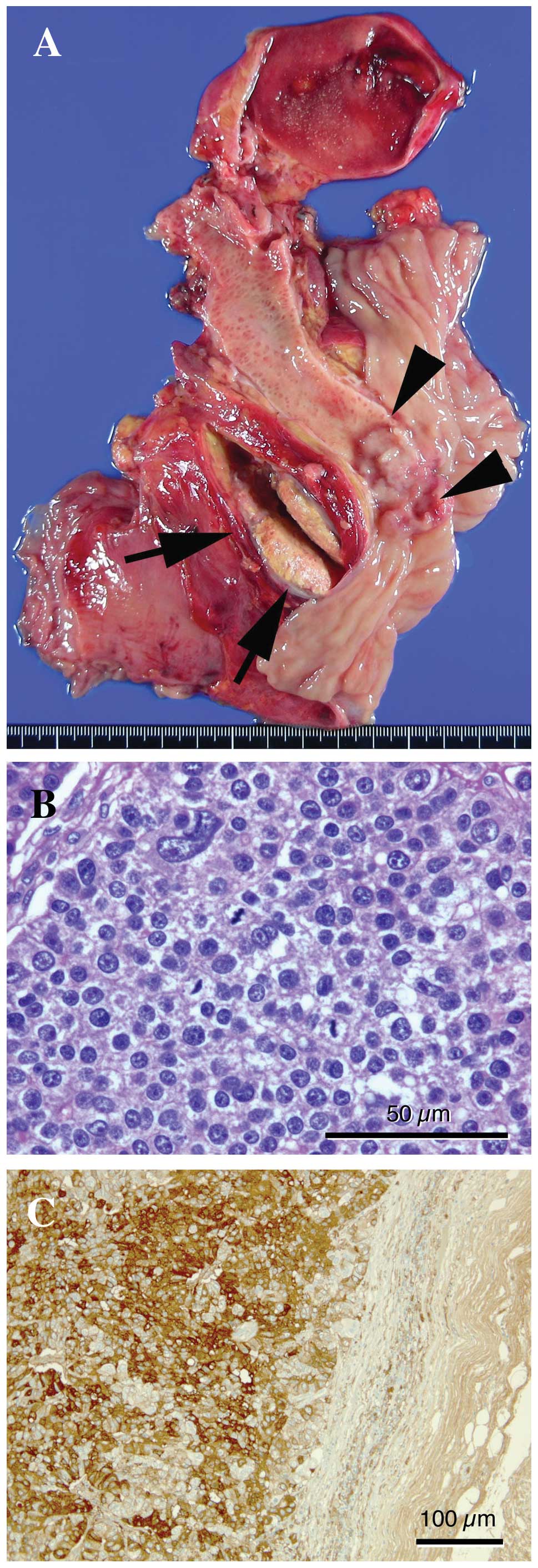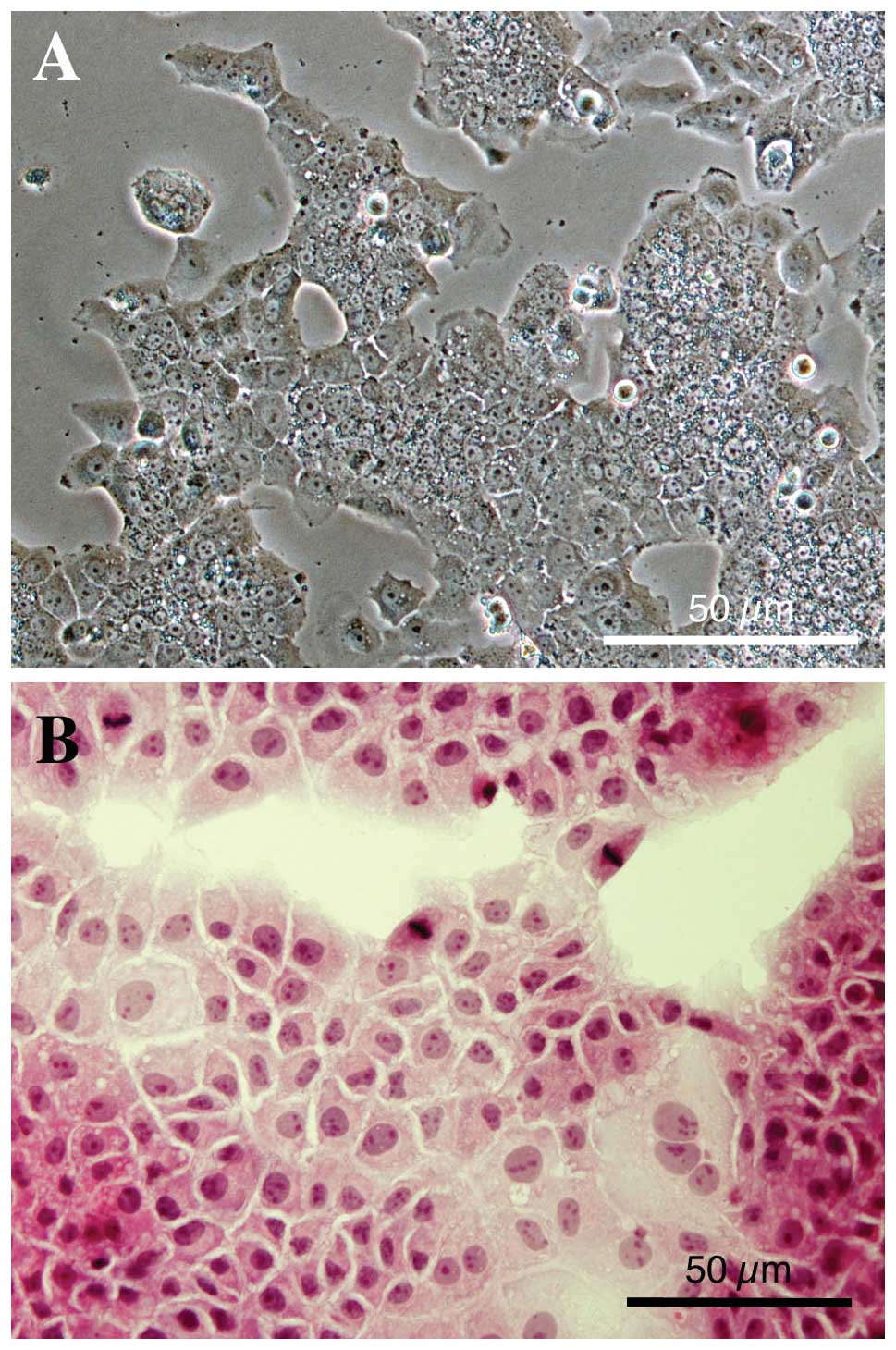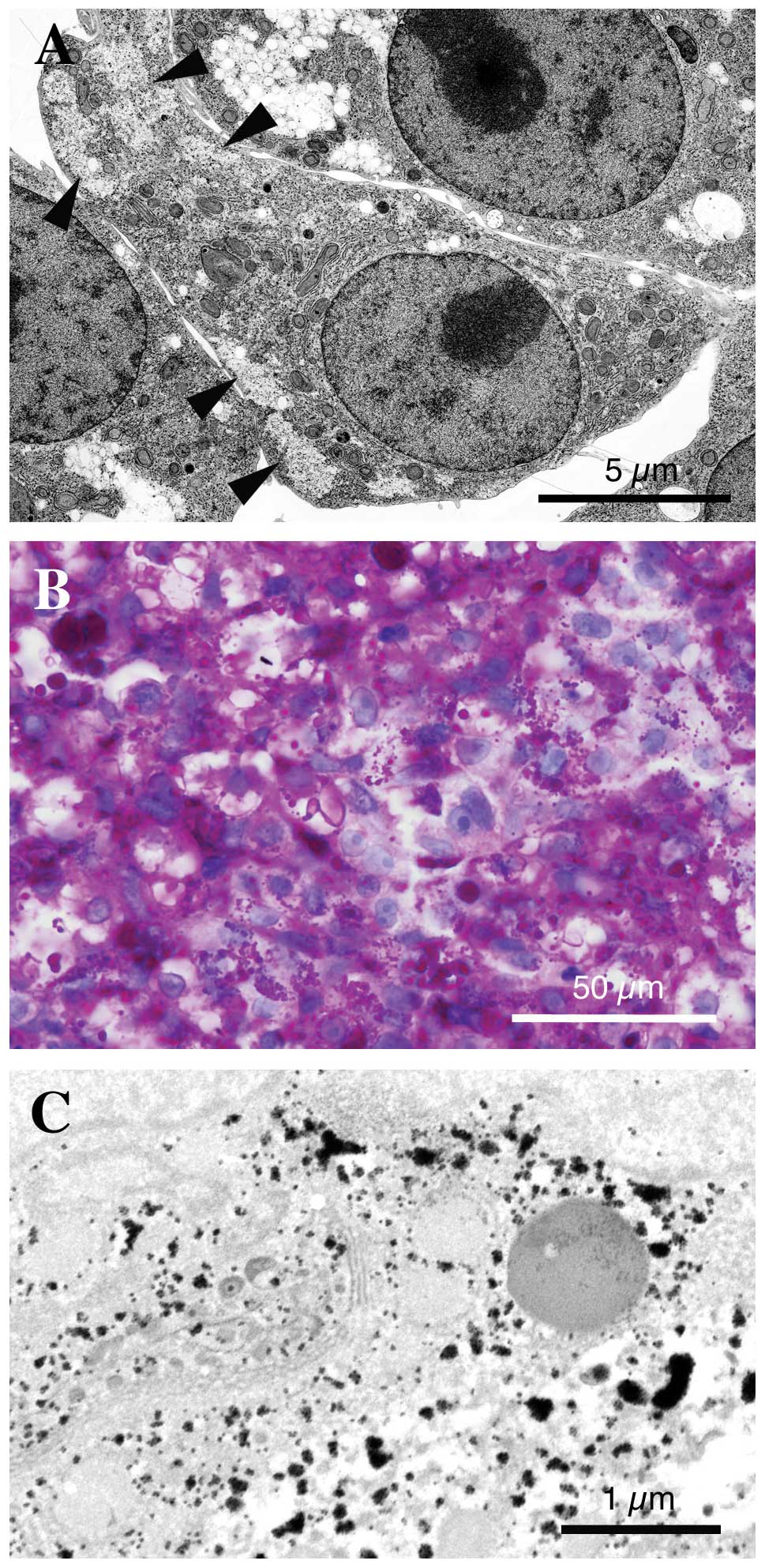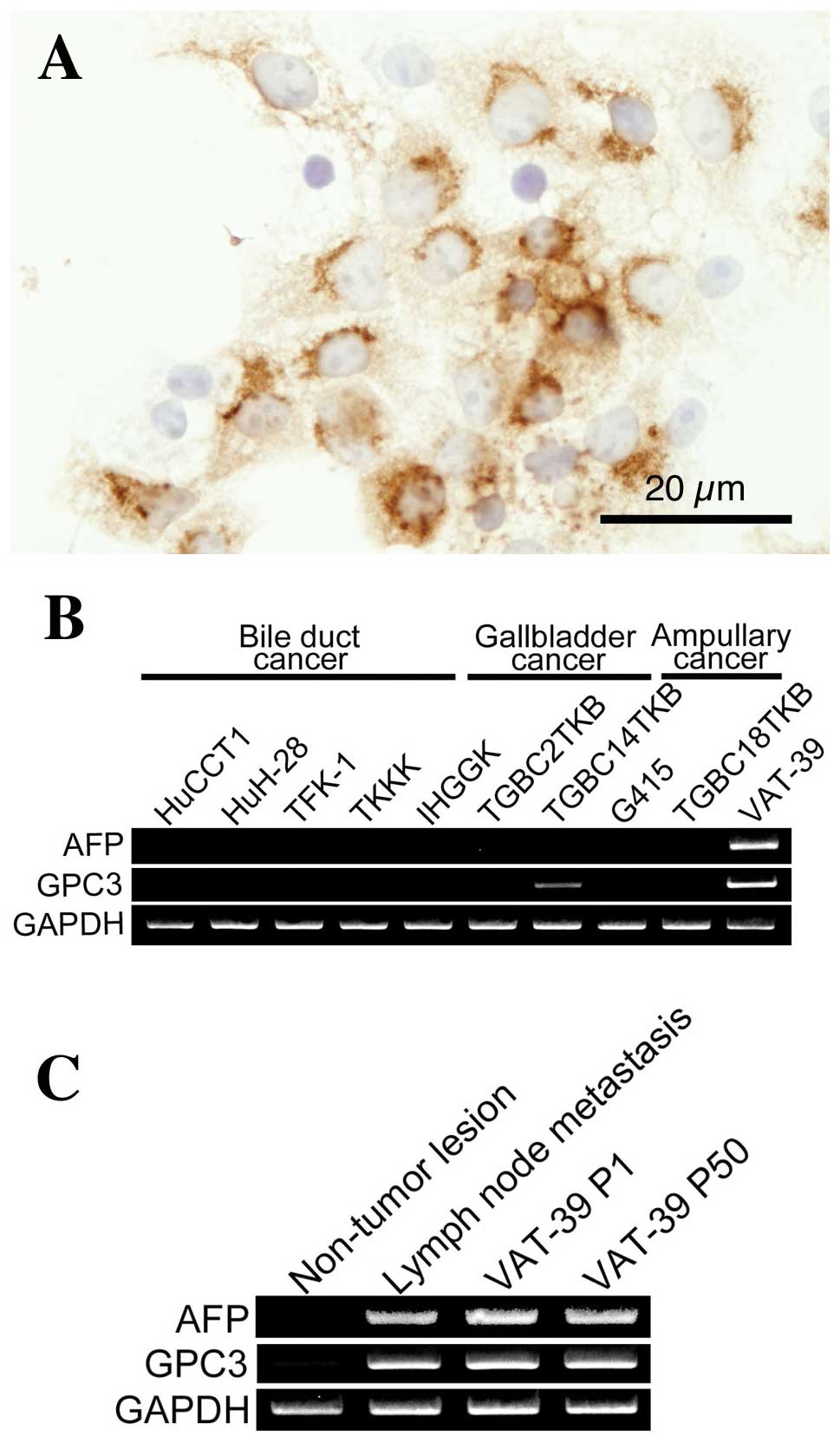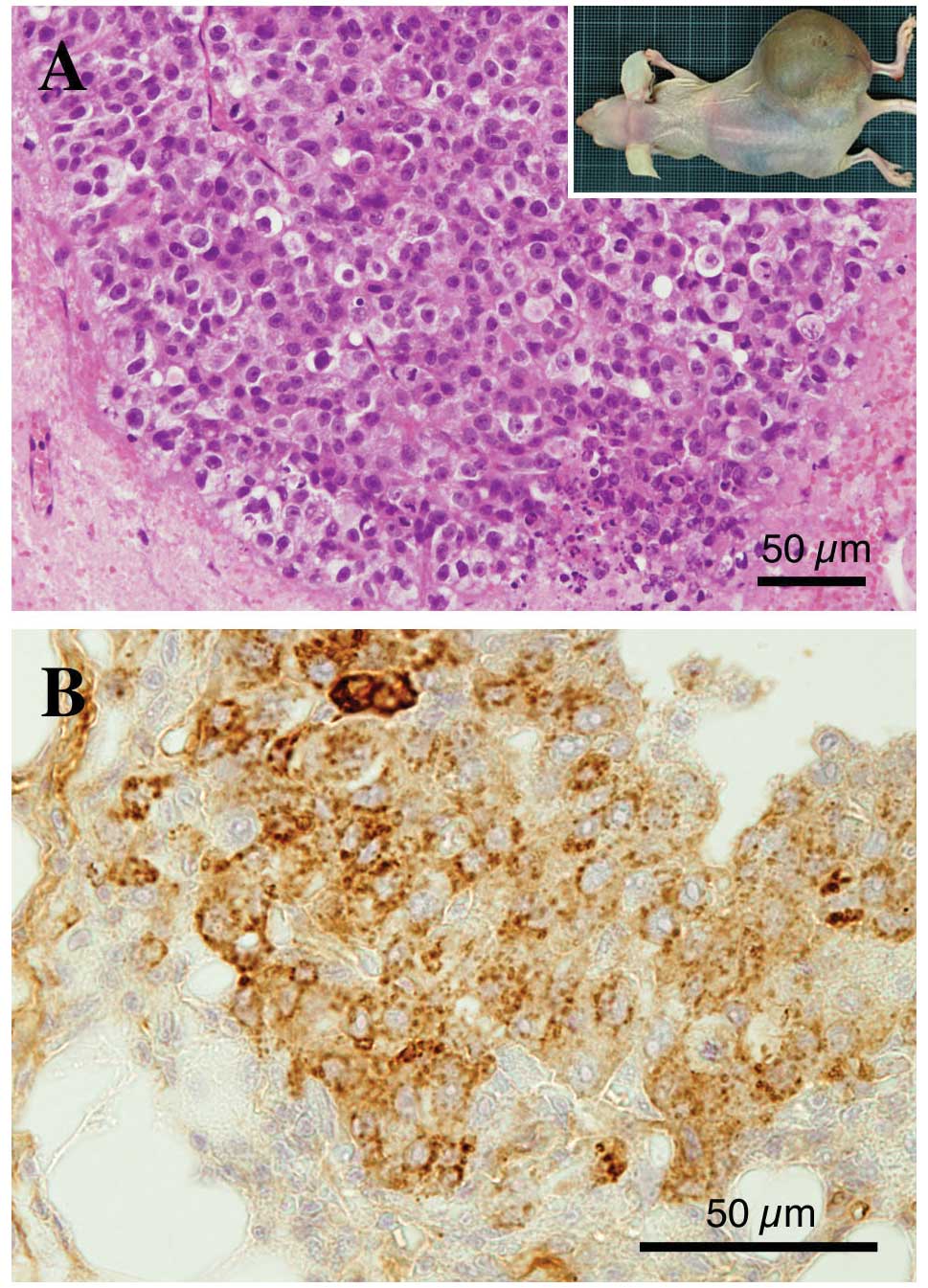|
1.
|
Bourreille J, Metayer P, Sauger F, Matray
F and Fondimare A: Existence of alpha fetoprotein during
gastric-origin secondary cancer of the liver. Presse Med.
78:1277–1278. 1970.In French.
|
|
2.
|
Ishikura H, Kirimoto K, Shamoto M, et al:
Hepatoid adenocarcinomas of the stomach. An analysis of seven
cases. Cancer. 58:119–126. 1986. View Article : Google Scholar : PubMed/NCBI
|
|
3.
|
Lattes C, Carella R, Faggioli S, Gabusi E
and Grigioni WF: Hepatoid adenocarcinoma of the rectum arising in
ulcerative colitis: report of a case. Dis Colon Rectum. 43:105–108.
2000. View Article : Google Scholar : PubMed/NCBI
|
|
4.
|
Paner GP, Thompson KS and Reyes CV:
Hepatoid carcinoma of the pancreas. Cancer. 88:1582–1589. 2000.
View Article : Google Scholar : PubMed/NCBI
|
|
5.
|
Arnould L, Drouot F, Fargeot P, et al:
Hepatoid adenocarcinoma of the lung: report of a case of an unusual
alpha-fetoprotein-producing lung tumor. Am J Surg Pathol.
21:1113–1118. 1997. View Article : Google Scholar : PubMed/NCBI
|
|
6.
|
Motoyama T, Higuchi M and Taguchi J:
Combined choriocarcinoma, hepatoid adenocarcinoma, small cell
carcinoma and tubular adenocarcinoma in the oesophagus. Virchows
Arch. 427:451–454. 1995. View Article : Google Scholar : PubMed/NCBI
|
|
7.
|
Gardiner GW, Lajoie G and Keith R:
Hepatoid adenocarcinoma of the papilla of Vater. Histopathology.
20:541–544. 1992. View Article : Google Scholar : PubMed/NCBI
|
|
8.
|
Sinard J, Macleay L Jr and Melamed J:
Hepatoid adenocarcinoma in the urinary bladder. Unusual
localization of a newly recognized tumor type. Cancer.
73:1919–1925. 1994. View Article : Google Scholar : PubMed/NCBI
|
|
9.
|
Ishikura H, Ishiguro T, Enatsu C, et al:
Hepatoid adenocarcinoma of the renal pelvis producing
alpha-fetoprotein of hepatic type and bile pigment. Cancer.
67:3051–3056. 1991. View Article : Google Scholar : PubMed/NCBI
|
|
10.
|
Devouassoux-Shisheboran M, Schammel DP and
Tavassoli FA: Ovarian hepatoid yolk sac tumours: morphological,
immunohistochemical and ultrastructural features. Histopathology.
34:462–469. 1999. View Article : Google Scholar : PubMed/NCBI
|
|
11.
|
Toyoda H, Hirai T and Ishii E:
Alpha-fetoprotein producing uterine corpus carcinoma: a hepatoid
adenocarcinoma of the endometrium. Pathol Int. 50:847–852. 2000.
View Article : Google Scholar : PubMed/NCBI
|
|
12.
|
Shintaku M, Kariya M, Shime H and Ishikura
H: Adenocarcinoma of the uterine cervix with choriocarcinomatous
and hepatoid differentiation: report of a case. Int J Gynecol
Pathol. 19:174–178. 2000. View Article : Google Scholar : PubMed/NCBI
|
|
13.
|
Kono K, Amemiya H, Sekikawa T, et al:
Clinicopathologic features of gastric cancers producing
alpha-fetoprotein. Dig Surg. 19:359–365. 2002. View Article : Google Scholar : PubMed/NCBI
|
|
14.
|
Takahashi Y, Mai M, Ogino T, Ueda H,
Sawaguchi K and Ueno M: Clinicopathological study of AFP producing
gastric cancer - significance of AFP in gastric cancer. Nihon Geka
Gakkai Zasshi. 88:696–700. 1987.In Japanese.
|
|
15.
|
Chang YC, Nagasue N, Abe S, Taniura H,
Kumar DD and Nakamura T: Comparison between the clinicopathologic
features of AFP-positive and AFP-negative gastric cancers. Am J
Gastroenterol. 87:321–325. 1992.
|
|
16.
|
Sekiguchi M, Fujii Y, Saito A, et al:
Alpha-fetoprotein-producing gastric carcinoma: biological
properties of a cultured cell line. J Gastroenterol. 30:589–598.
1995. View Article : Google Scholar : PubMed/NCBI
|
|
17.
|
Matsuda M, Watanabe A, Sawada H, et al:
Establishment of an alpha-fetoprotein-producing cell line derived
from gastric cancer. In Vitro Cell Dev Biol Anim. 35:555–557. 1999.
View Article : Google Scholar : PubMed/NCBI
|
|
18.
|
Terashima M, Ikeda K, Maesawa C, et al:
Establishment of an alpha-fetoprotein-producing gastric cancer cell
line in serum-free media. Jpn J Cancer Res. 82:883–885. 1991.
View Article : Google Scholar : PubMed/NCBI
|
|
19.
|
Takahashi Y, Ohta T and Mai M:
Angiogenesis of AFP producing gastric carcinoma: correlation with
frequent liver metastasis and its inhibition by anti-AFP antibody.
Oncol Rep. 11:809–813. 2004.
|
|
20.
|
Sawaguchi A, McDonald KL and Forte JG:
High-pressure freezing of isolated gastric glands provides new
insight into the fine structure and subcellular localization of
H+/K+-ATPase in gastric parietal cells. J
Histochem Cytochem. 52:77–86. 2004. View Article : Google Scholar
|
|
21.
|
Sawaguchi A, Aoyama F, Ide S, Goto Y and
Suganuma T: A new device for high-pressure freezing of cultured
cell monolayer using 10-micron-thin stainless discs as both culture
plate and specimen carrier. J Electron Micros. 57:203–206. 2008.
View Article : Google Scholar
|
|
22.
|
Sawaguchi A, Aoyama F, Ide S and Suganuma
T: Capsule-supporting ring: a new device for resin embedding of
glass-mounted specimens. J Microsc. 234:113–117. 2009. View Article : Google Scholar : PubMed/NCBI
|
|
23.
|
Aoyama F, Sawaguchi A, Ide S, Kitamura K
and Suganuma T: Exfoliation of gastric pit-parietal cells into the
gastric lumen associated with a stimulation of isolated rat gastric
mucosa in vitro: a morphological study by the application of
cryotechniques. Histochem Cell Biol. 129:785–793. 2008. View Article : Google Scholar
|
|
24.
|
Terracciano LM, Glatz K, Mhawech P, et al:
Hepatoid adenocarcinoma with liver metastasis mimicking
hepatocellular carcinoma: an immunohistochemical and molecular
study of eight cases. Am J Surg Pathol. 27:1302–1312. 2003.
View Article : Google Scholar
|
|
25.
|
Muehlemann M, Miller KD, Dauphinee M and
Mizejewski GJ: Review of growth inhibitory peptide as a
biotherapeutic agent for tumor growth, adhesion, and metastasis.
Cancer Metastasis Rev. 24:441–467. 2005. View Article : Google Scholar : PubMed/NCBI
|
|
26.
|
Nagai E, Ueyama T, Yao T and Tsuneyoshi M:
Hepatoid adenocarcinoma of the stomach. A clinicopathologic and
immunohistochemical analysis. Cancer. 72:1827–1835. 1993.
View Article : Google Scholar : PubMed/NCBI
|
|
27.
|
Yorita K, Takahashi N, Takai H, et al:
Prognostic significance of circumferential cell surface
immunoreactivity of glypican-3 in hepatocellular carcinoma. Liver
Int. 31:120–131. 2011. View Article : Google Scholar : PubMed/NCBI
|
|
28.
|
Hishinuma M, Ohashi KI, Yamauchi N, et al:
Hepatocellular oncofetal protein, glypican 3 is a sensitive marker
for alpha-fetoprotein-producing gastric carcinoma. Histopathology.
49:479–486. 2006. View Article : Google Scholar
|
|
29.
|
Morford LA, Davis C, Jin L, Dobierzewska
A, Peterson ML and Spear BT: The oncofetal gene glypican 3 is
regulated in the postnatal liver by zinc fingers and homeoboxes 2
and in the regenerating liver by alpha-fetoprotein regulator 2.
Hepatology. 46:1541–1547. 2007. View Article : Google Scholar
|
|
30.
|
Nakano K, Orita T, Nezu J, et al:
Anti-glypican 3 antibodies cause ADCC against human hepatocellular
carcinoma cells. Biochem Biophys Res Commun. 378:279–284. 2009.
View Article : Google Scholar : PubMed/NCBI
|
|
31.
|
Ishiguro T, Sugimoto M, Kinoshita Y, et
al: Anti-glypican 3 antibody as a potential antitumor agent for
human liver cancer. Cancer Res. 68:9832–9838. 2008. View Article : Google Scholar : PubMed/NCBI
|



